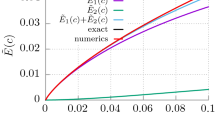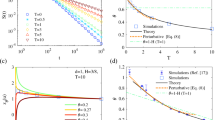Abstract
We presented experimental evidence for the existence of microscopic chaos in the mesoscopic motion of a brownian particle in solution. We used standard techniques to analyse long trajectories of a brownian particle and inferred a dynamical entropy from this analysis. We showed that this dynamical entropy can be accessed experimentally by measuring multiple-time correlation functions for the particle. The dynamical entropy was then used to provide a positive lower bound for the sum of the Lyapunov exponents for the underlying deterministic dynamical system composed of the fluid and brownian particles. We concluded that the positive dynamical entropy, obtained experimen-tally, was evidence for the existence of positive Lyapunov exponents in the underlying dynamics, and hence for the existence of microscopic chaos generated by a dynamical instability.
Similar content being viewed by others
Gaspard et al. reply
Dettmann et al. and Grassberger and Schreiber argue that there may be other explanations. There is no doubt that a positive dynamical entropy could be generated by mechanisms other than a local intrinsic, dynamical instability. Illustrative models include the Rayleigh flight of a tracer particle in a non-interacting ideal gas, the motion of an impurity in a harmonic crystal, and the motion of the wind particle in the wind-tree model. In these models, an external pseudorandom generator must be involved at some stage of the simulation of the dynamics, leading to a positive dynamical entropy without a local dynamical instability.
In the Rayleigh flight and the harmonic crystal, randomness is generated repetitively by the new particles or waves continuously coming from infinity. In the wind-tree model, the scatterers are randomly located by using a pseudorandom generator before the simulation of the time evolution. As the wind particle collides with a new scatterer, it picks up new information on the location of this scatterer and the information recorded on this trajectory grows as a result. However, if the square scatterers formed a regular lattice, this growth would stop and the dynamical entropy would vanish. In contrast, for circular disks, as in the Lorentz gas, the dynamical entropy is always positive whether the lattice is regular or not. The apparent dynamical randomness of the wind-tree model therefore has its origin in the structural disorder of the model.
The models mentioned by Dettmann et al. and Grassberger and Schreiber fail to capture an essential feature of brownian motion: that the diffusion coefficient is inversely proportional to the viscosity of the fluid surrounding the brownian particle. The viscosity of the fluid is absent in models in which the surrounding particles either do not move or have no interaction or only harmonic interactions. These models are therefore not plausible for the interpretation of our experiment1.
However, if the interactions between surrounding particles are generic and nonlinear, the viscosity can be positive and the dependence of the diffusion coefficient on the viscosity can be explained. In such systems with nonlinearly interacting particles, numerical and analytical studies have shown that intrinsic local instability is the dominant mechanism for generating dynamical randomness, and no external pseudorandom generator is needed2,3. Standard models of brownian motion are of this kind and develop chaotic dynamics with a full spectrum of positive Lyapunov exponents.
For these reasons, we believe that our explanation in terms of a randomness self-generated by the dynamical instability is the most plausible one for this experiment. We hope that further experiments will be able to distinguish more directly between different regimes of random behaviour in systems with a large number of particles, and so provide further evidence of microscopic chaos.
References
Gaspard, P. et al. Nature 394, 865–868 (1998).
Posch, H. A. & Hoover, W. G. Phys. Rev. A 38, 473–482 (1988).
van Beijeren, H., Dorfman, J. R., Posch, H. A. & Dellago, C. Phys. Rev. E 56, 5272–5277 (1997).
Author information
Authors and Affiliations
Rights and permissions
About this article
Cite this article
Gaspard, P., Briggs, M., Francis, M. et al. Microscopic chaos from brownian motion?. Nature 401, 876 (1999). https://doi.org/10.1038/44764
Issue Date:
DOI: https://doi.org/10.1038/44764
Comments
By submitting a comment you agree to abide by our Terms and Community Guidelines. If you find something abusive or that does not comply with our terms or guidelines please flag it as inappropriate.



